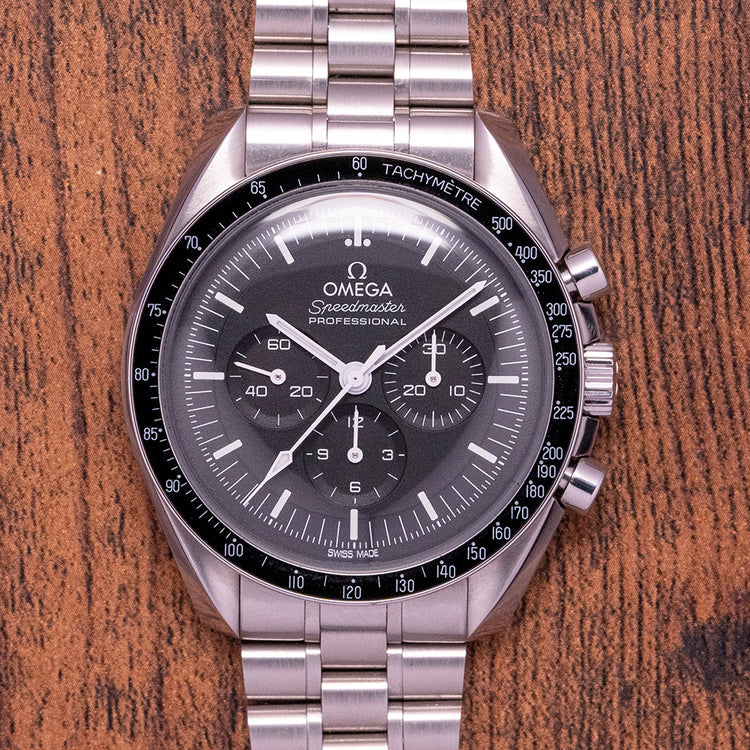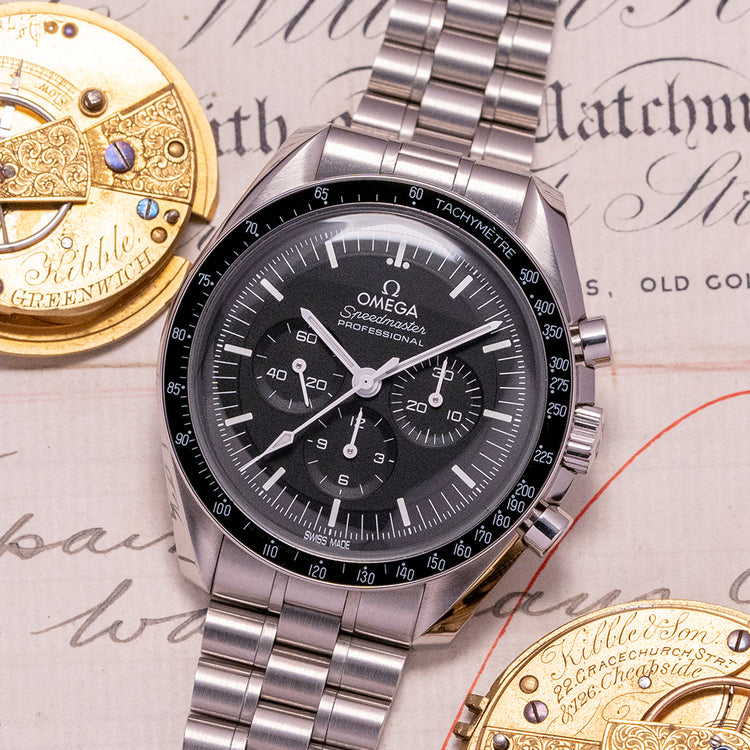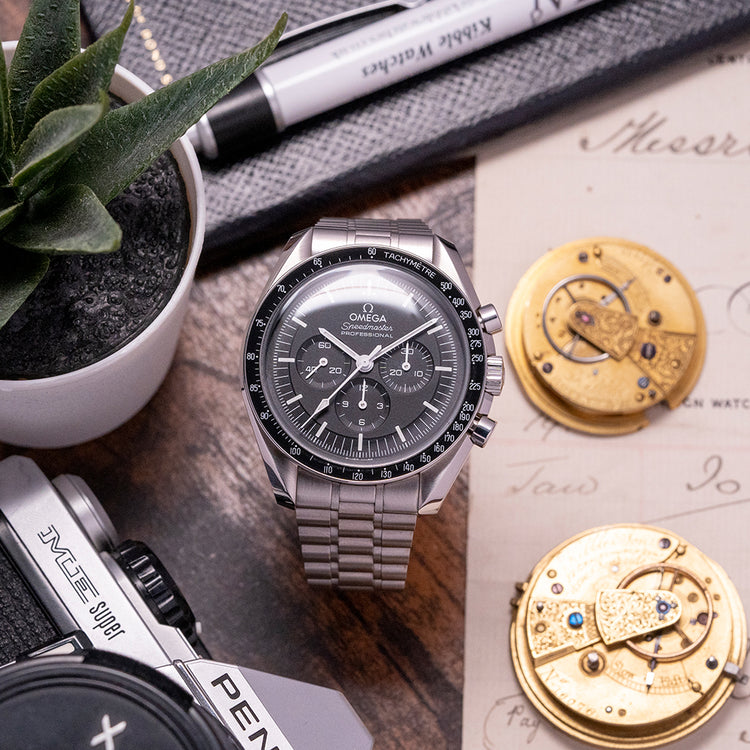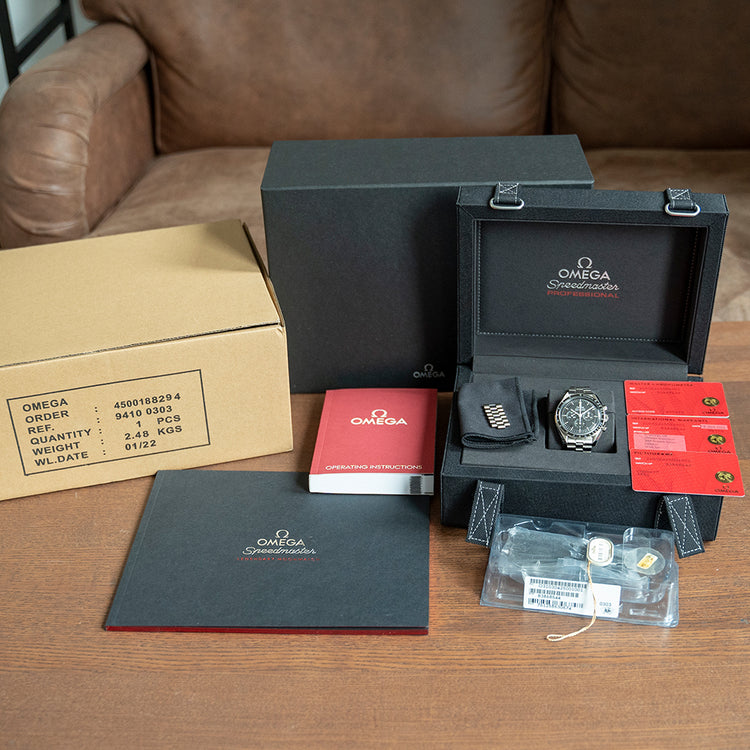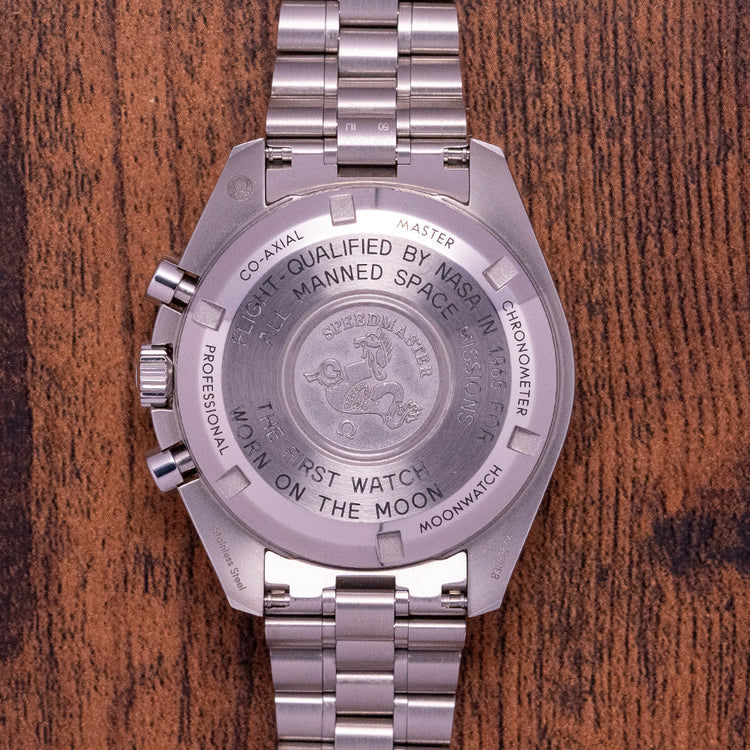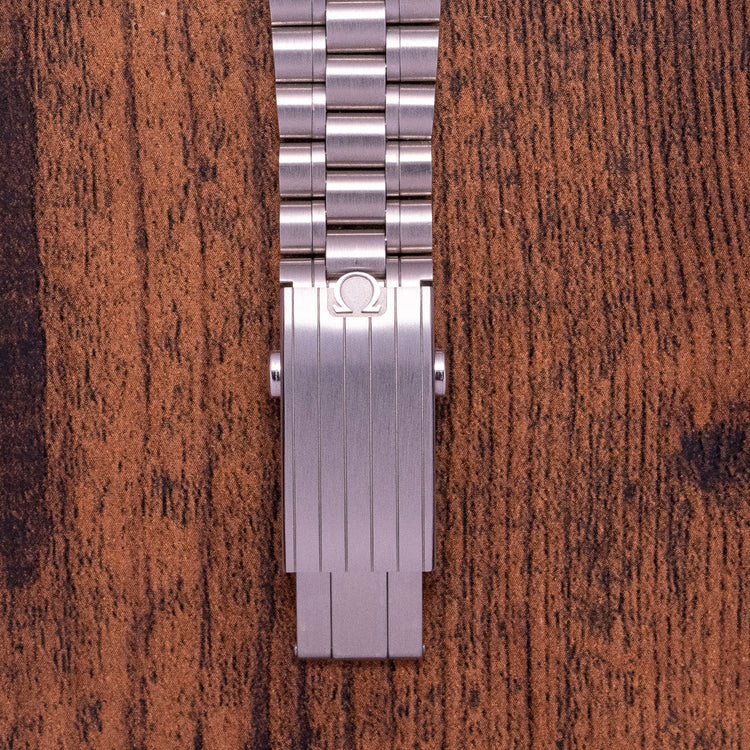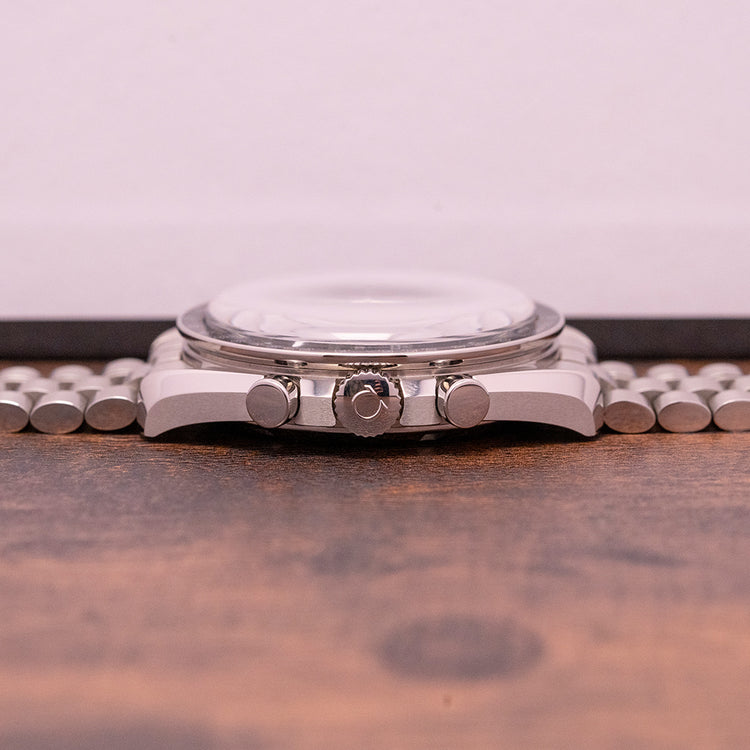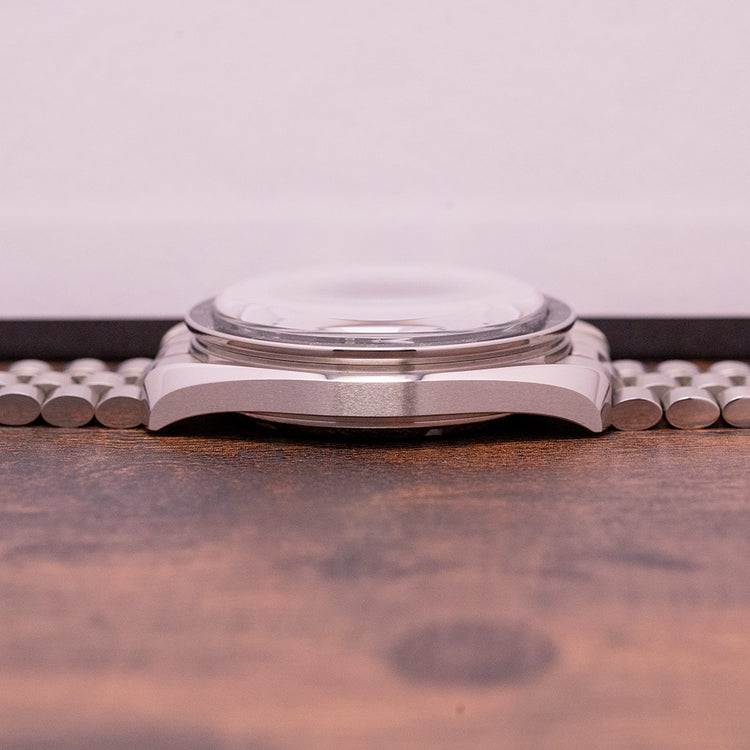More Information
Description
More
Less
The Watch
Here we have a 2023 Omega Speedmaster Professional Hesalite Cal. 3861, the 42mm stainless steel case has polished and brushed surfaces that lead to twisted tapering lugs, the crisp lines transition effortlessly around the case, and a lug-to-lug length of 47mm and a case thickness of 14mm ensure a comfortable fit on the wrist. Omega has used modern tomography technology to achieve the exact dimensions of the 4th generation Speedmaster case as worn by the Apollo 11 Astronauts. Down the right side, we have the pushers and signed crown protected by crown guards that continue the flow of the asymmetrical case. A fixed tachymeter sits on its black bezel with an iconic “dot” over the ninety, the stepped dial adds depth and interest and is protected by a Hesalite crystal. An outer minute track with slim baton indexes marking the hours, 3 recessed Sub-dials consist of 60 seconds, 30 minutes, and 12 hours. Luminance filled Sword's hands and an elegant long central teardrop tipped chronograph seconds hand accurately hits the minute track, the dial has perfect symmetry, form and function. The screw-down case back is engraved with “Flight - Qualified By NASA in 1965 for all Manned Space Missions” and “The First watch worn on the Moon” a fitting testament to man's achievements in space. Around its outer edge, we have the “Professional Moonwatch Co-Axial Master Chronometer.” The embossed Hippocampus in the centre represents Neptune the God of the sea, it was conceived by Pierre Borie after seeing a picture of Neptune riding a chariot pulled by seahorses, it is the reason why the seahorses are wearing a bridle. Inside a manually wound Omega Master Chronometer Calibre 3861 featuring a CO-Axial and column-wheel, COSC-certified 26 jewels, 21,600 beats per hour, METAS (Federal Institute of Metrology) also certified this special movement with additional measurements of precision, performance, and anti-magnetic resistance. The continued commitment by Omega to push the envelope of a watch and its movement means it is still the only flight-qualified watch that meets the requirements for EVA (Extravehicular activity) – outperforming quartz watches, with LCD displays, which are vulnerable to temperature changes, and literally, get destroyed when on spacewalks. The watch comes fitted on its Omega 20mm brushed stainless steel 5-link bracelet which tapers to 15mm with a signed push button release newly designed milled clasp and the watch also comes with its Omega presentation box and paperwork.
Points of Mention
This watch is sold with its original Omega box and Omega paperwork. The watch comes paired with its original Omega bracelet with its signed clasp, all links are included with the watch. The watch is from January 2023 and is sold in worn condition, but overall in very good condition as you can see. The watch comes with its original Manufacturer's Warranty.
For more photos see here - https://drive.google.com/drive/folders/1VXvYuT8RvHDb-7_86RKxSicibioKQq31?usp=drive_link
4K YouTube video, skip to 2:08 - https://youtu.be/rDjaU3Q5dmk
Personal Note
This latest reference Speedmaster has been the upgrade that so many were waiting for, the now perfect modern Speedmaster! The upgraded Co-Axial movement brings the Speedmaster in line with the rest of modern Omega in terms of movement quality, the upgraded bracelet with its aggressive taper suits the design perfectly... All of this whilst keeping the core of the Speedmaster exactly as you'd expect, what's not to like?
Specification
Lugs : 20mm
Condition : Pre-Owned
Box & Papers : Box & Papers
Case Material : Stainless Steel
Warranty : Manufacturer Warranty
The Brand
Formerly known as the La Generale Watch Co. in 1848 founded by Louis Brandt in La Chaux-de-Fonds. When he died in 1879, his sons carried on his dream. In 1880 they moved to 96 Rue Jakob-Stampfli where they remain today. The brothers produced their first mass-produced calibre, the Labrador In 1885. Just a few years later in 1892, they produced the first minute-repeater. In 1903 they renamed the company Omega until 1982 when they officially changed their name to Omega SA. During WW1 Omega watches were used as official timekeepers for the Royal Flying Corps and the US Army. In 1930, Omega and Tissot merged together to form Société Suisse pour l'Industrie Horlogère (SSIH) In 1931, another group was formed - Allgemeine Schweizerische Uhrenindustrie AG (ASUAG). Where SSIH was primarily French-speaking, ASUAG was founded by the more German-speaking members of the Swiss watch industry. In 1948 they introduced the first edition of one of its most symbolic watches: the Seamaster. Omega first introduced the Constellation in 1952. At the time it was Omega's flagship timepiece. The first models had a Cal. 354 bumper movement in them. Later in 1955, Omega introduced the Automatic Cal. 50x, followed in 1959 by the Cal.55x (no date) and 56x (date) versions. Many of the Constellations came with pie-pan dials, diamond indexes, and fancy lug configurations. All the gold Constellations of that time have the Observatory of Geneva hand engraved on the back. The stainless steel and stainless steel/gold versions had a gold medallion on the back with the Observatory of Geneva. The eight stars above the Observatory stand for the many exploits of Omega in the world Chronometer competition. Celebrating the fact that all Constellations are Chronometer Certified. In 1962, when astronaut Wally Schirra wore a Speedmaster on his Mercury Sigma 7 Mission, making it the first Omega watch to enter space. After rigorous tests, NASA used Omega for all their Apollo missions including the 1969 Moon landing of Apollo 11. Today Omega is still an astronaut's first choice. In 1969, President Nixon famously said it was “too valuable” and turned down the first-ever all-gold Speedmaster Professional Deluxe. As a response to the ever-growing threat of electronic watches to the manufacturers of mechanical watches, Omega and many Swiss brands such as Rolex and Patek Philippe formed Centre Electronique Horologer (CEH). Prototypes began to appear in 1967 with their production starting in 1968. Then In 1972, Omega introduced the reference, 198.030, which included the Omega calibre 1250, a ‘tuning-fork electronic movement which was made under licence from Bulova. Later we saw a merger of SSIH and ASUAG into SMH, or Société de Microélectronique et d’Horlogerie. This merger took place in 1983. In 1992, the company acquired Blancpain, and in 1998 they officially rebranded themselves from SMH to the Swatch Group. Then, in 1999, they purchased and integrated Breguet into the Swatch Group.
Points of Mention
More
Less
Personal Note
More
Less
Specification
More
Less
Movement : Manually Wound Omega Cal. 3861
Age : January 2023
Year : 2023
Case Size : 42mm
Case Thickness : 14 mm
Lug to Lug : 47mm
Lugs : 20mm
Condition : Pre-Owned
Case Material : Stainless Steel
Warranty : Manufacturer Warranty
The wrist model's wrist size is 7inch
About Omega
More
Less
Description
The Watch
Here we have a 2023 Omega Speedmaster Professional Hesalite Cal. 3861, the 42mm stainless steel case has polished and brushed surfaces that lead to twisted tapering lugs, the crisp lines transition effortlessly around the case, and a lug-to-lug length of 47mm and a case thickness of 14mm ensure a comfortable fit on the wrist. Omega has used modern tomography technology to achieve the exact dimensions of the 4th generation Speedmaster case as worn by the Apollo 11 Astronauts. Down the right side, we have the pushers and signed crown protected by crown guards that continue the flow of the asymmetrical case. A fixed tachymeter sits on its black bezel with an iconic “dot” over the ninety, the stepped dial adds depth and interest and is protected by a Hesalite crystal. An outer minute track with slim baton indexes marking the hours, 3 recessed Sub-dials consist of 60 seconds, 30 minutes, and 12 hours. Luminance filled Sword's hands and an elegant long central teardrop tipped chronograph seconds hand accurately hits the minute track, the dial has perfect symmetry, form and function. The screw-down case back is engraved with “Flight - Qualified By NASA in 1965 for all Manned Space Missions” and “The First watch worn on the Moon” a fitting testament to man's achievements in space. Around its outer edge, we have the “Professional Moonwatch Co-Axial Master Chronometer.” The embossed Hippocampus in the centre represents Neptune the God of the sea, it was conceived by Pierre Borie after seeing a picture of Neptune riding a chariot pulled by seahorses, it is the reason why the seahorses are wearing a bridle. Inside a manually wound Omega Master Chronometer Calibre 3861 featuring a CO-Axial and column-wheel, COSC-certified 26 jewels, 21,600 beats per hour, METAS (Federal Institute of Metrology) also certified this special movement with additional measurements of precision, performance, and anti-magnetic resistance. The continued commitment by Omega to push the envelope of a watch and its movement means it is still the only flight-qualified watch that meets the requirements for EVA (Extravehicular activity) – outperforming quartz watches, with LCD displays, which are vulnerable to temperature changes, and literally, get destroyed when on spacewalks. The watch comes fitted on its Omega 20mm brushed stainless steel 5-link bracelet which tapers to 15mm with a signed push button release newly designed milled clasp and the watch also comes with its Omega presentation box and paperwork.
Points of Mention
This watch is sold with its original Omega box and Omega paperwork. The watch comes paired with its original Omega bracelet with its signed clasp, all links are included with the watch. The watch is from January 2023 and is sold in worn condition, but overall in very good condition as you can see. The watch comes with its original Manufacturer's Warranty.
For more photos see here - https://drive.google.com/drive/folders/1VXvYuT8RvHDb-7_86RKxSicibioKQq31?usp=drive_link
4K YouTube video, skip to 2:08 - https://youtu.be/rDjaU3Q5dmk
Personal Note
This latest reference Speedmaster has been the upgrade that so many were waiting for, the now perfect modern Speedmaster! The upgraded Co-Axial movement brings the Speedmaster in line with the rest of modern Omega in terms of movement quality, the upgraded bracelet with its aggressive taper suits the design perfectly... All of this whilst keeping the core of the Speedmaster exactly as you'd expect, what's not to like?
Specification
Lugs : 20mm
Condition : Pre-Owned
Box & Papers : Box & Papers
Case Material : Stainless Steel
Warranty : Manufacturer Warranty
The Brand
Formerly known as the La Generale Watch Co. in 1848 founded by Louis Brandt in La Chaux-de-Fonds. When he died in 1879, his sons carried on his dream. In 1880 they moved to 96 Rue Jakob-Stampfli where they remain today. The brothers produced their first mass-produced calibre, the Labrador In 1885. Just a few years later in 1892, they produced the first minute-repeater. In 1903 they renamed the company Omega until 1982 when they officially changed their name to Omega SA. During WW1 Omega watches were used as official timekeepers for the Royal Flying Corps and the US Army. In 1930, Omega and Tissot merged together to form Société Suisse pour l'Industrie Horlogère (SSIH) In 1931, another group was formed - Allgemeine Schweizerische Uhrenindustrie AG (ASUAG). Where SSIH was primarily French-speaking, ASUAG was founded by the more German-speaking members of the Swiss watch industry. In 1948 they introduced the first edition of one of its most symbolic watches: the Seamaster. Omega first introduced the Constellation in 1952. At the time it was Omega's flagship timepiece. The first models had a Cal. 354 bumper movement in them. Later in 1955, Omega introduced the Automatic Cal. 50x, followed in 1959 by the Cal.55x (no date) and 56x (date) versions. Many of the Constellations came with pie-pan dials, diamond indexes, and fancy lug configurations. All the gold Constellations of that time have the Observatory of Geneva hand engraved on the back. The stainless steel and stainless steel/gold versions had a gold medallion on the back with the Observatory of Geneva. The eight stars above the Observatory stand for the many exploits of Omega in the world Chronometer competition. Celebrating the fact that all Constellations are Chronometer Certified. In 1962, when astronaut Wally Schirra wore a Speedmaster on his Mercury Sigma 7 Mission, making it the first Omega watch to enter space. After rigorous tests, NASA used Omega for all their Apollo missions including the 1969 Moon landing of Apollo 11. Today Omega is still an astronaut's first choice. In 1969, President Nixon famously said it was “too valuable” and turned down the first-ever all-gold Speedmaster Professional Deluxe. As a response to the ever-growing threat of electronic watches to the manufacturers of mechanical watches, Omega and many Swiss brands such as Rolex and Patek Philippe formed Centre Electronique Horologer (CEH). Prototypes began to appear in 1967 with their production starting in 1968. Then In 1972, Omega introduced the reference, 198.030, which included the Omega calibre 1250, a ‘tuning-fork electronic movement which was made under licence from Bulova. Later we saw a merger of SSIH and ASUAG into SMH, or Société de Microélectronique et d’Horlogerie. This merger took place in 1983. In 1992, the company acquired Blancpain, and in 1998 they officially rebranded themselves from SMH to the Swatch Group. Then, in 1999, they purchased and integrated Breguet into the Swatch Group.
Points of Mention
Personal Note
Specification
The Brand
Enquire or Book an Appointment
Would you like to discover further details about this watch, or perhaps arrange an appointment to view and try it on? Complete this form and a member of our team will get back to you shortly.
You May Also Like




















